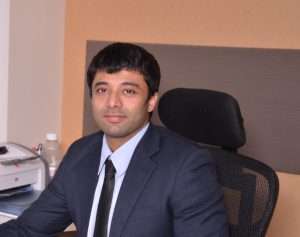While many fund houses, in recent times, have been favouring ‘value’ strategy for investing in this market, Paul Parampreet, Fund Manager, Edelweiss AMC would rather adopt a GARP (Growth At Reasonable Price) style of investing in the current market. FundsIndia had a Q&A with Parampreet on where the market is headed and how Edelweiss AMC managed to contain volatility in its funds in the recent market turbulence.
Excerpts:

Has the recent rally made the market ‘fairly valued?’
The recent rally is fuelled by global liquidity, an anticipation of bottoming out in earnings and election results. So, as such it is a rally of hope and has led to correction in the valuation gap between defensive and cyclical stocks.
Though results were better than expectation for most of the companies, high inflation and high interest rate will continue to be an overhang along with macro environment.
Nifty Index is trading slightly above its historical PE of 15 times, but there are enough pockets of expensive defensives and deep value cyclicals.
We have had markets making a full circle, back to the 21K of early 2008, although earnings expanded decently. Do you think there is yet a pent-up rally waiting to happen if one considers the earnings growth?
In 2008 markets ran way ahead of its fundamentals; we were trading at more than 23X PE, so correction was bound to happen. This time, however, we are not looking as stretched as we were in 2007-08. After 5 years of consolidation/correction we do feel that the levels are more sanguine, but we will see a big rally only if macro-economic scenario turns favourable.
What could be the key triggers for such a rally?
There are various factors which will be governing the direction for the markets: Clarity on QE tapering, favourable inflation/growth dynamics, bottoming out of earnings, and election results. All of these are likely to play out over the next 6 months or so. Therefore, the current rally will find more sustainable legs if events turn out to be favourable.
Do you think the polarization of valuations between segments of the markets is too stark now to be ignored? Could this be the time to be choosy and pick ‘value’?
Different sectors of the market are governed by different factors. For example, FMCG continues to be driven by the consumption story and has seen some multiple contraction in terms of PE as growth seems to be slowing.
IT and pharma sectors have benefitted due to improving economic scenarios in the developed markets as well as the Rupee depreciation. Though the depreciating rupee and improving external economic scenario have also helped the auto and metal sectors, the current high inflation and interest rate scenarios are not favouring auto.
So, pure value picks might continue to languish as growth pickup is likely to be narrow in the beginning. We would rather adopt a GARP style – Growth At Reasonable Price for the current market scenario.
Why is the valuation gap between large and mid-cap stocks very wide this time around, compared with earlier occasions?
As the current rally is driven due to liquidity provided by FII inflows, the rally has been led by large caps. This has created a stark valuation gap between the large caps and the mid caps.
Historically it has been seen that while large Cap stocks tend to lead the recovery, midcap stocks eventually take charge and tend to outperform the large Cap stocks over a long term. Hence it makes a strong case for investing in Midcap Universe with a 18 months to 3-year horizon.
Edelweiss Diversified Growth Equity Top 100 fund has been a consistent performer. We do know you use a quantitative approach. Could you explain it?
The primary reasons for consistency are two folds:
– Quantitative strategies, due to their objective nature, can be back tested over long periods of time and through several types of market environments to better understand how they behave. It is for these reasons that quant models can achieve consistent performance, within defined range, across time periods. They are robust in various market conditions and generate better risk-to-reward ratio as well.
– Large universe of stocks can be statistically evaluated and allocation decisions can be made with greater confidence. So scalability is relatively easier.
The funds are more actively managed, with the fund manager using his judgment to invest in strategies that are in accord with the current market and macroeconomic scenarios. Also, a lot of discipline is exercised in the final portfolio selection to ensure low tracking error with respect to the benchmark. The advantages of quant focus, along with the investment management discipline that it entails, have helped the funds to consistently deliver on their mandates.
What is the objective and strategy of your Absolute Return fund? On what basis does the fund shift between equity and debt allocation?
Edelweiss ARF aims to provide investors with two benefits. Firstly, a consistent return stream that has low correlation with other funds and investment options available. Second, the fund aims to protect investors from the volatility that is inherent in Indian equity markets.
The essence of Edelweiss ARF is captured by the following four points:
– Participation on the upside: Endeavour to provide investors with maximum of the Nifty upside in a positive twelve months period.
– Protection from the downside: Endeavour to restrict investor losses minimum of Nifty downside in any twelve months period
– Low correlation with other funds and investment options available: The fund provides uncorrelated returns to the market by using a multi-strategy approach. It has a low beta of ~0.15 relative to Nifty.
– Protect investors from the volatility that is inherent in Indian equity markets: The fund endeavors to keep its volatility less than one third of Nifty.
This objective is achieved through a static allocation to diversified long-only equity and debt portfolios. Exposure to the long-only equity portfolio is hedged dynamically to achieve the objectives and thus there is no shift from debt to equity.
Does a small asset base not add to the risk element in your schemes, as far as an investor is concerned? How do you alleviate this concern?
Since all our investments are in top 300 market cap stocks which are liquid and traded daily, there is little risk involved during redemption as stocks are easily tradable.
Mutual Fund investments are subject to market risks, read all scheme related documents carefully.







